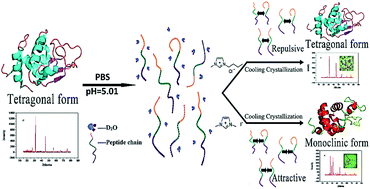当前位置:
X-MOL 学术
›
CrystEngComm
›
论文详情
Our official English website, www.x-mol.net, welcomes your
feedback! (Note: you will need to create a separate account there.)
Manipulating crystallization in lysozyme and supramolecular self-arrangement in solution using ionic liquids†
CrystEngComm ( IF 2.6 ) Pub Date : 2018-03-22 00:00:00 , DOI: 10.1039/c8ce00107c Zhanzhong Wang 1, 2, 3, 4 , Tiankuo Liu 1, 2, 3, 4 , Chao Lu 1, 2, 3, 4 , Leping Dang 1, 2, 3, 4
CrystEngComm ( IF 2.6 ) Pub Date : 2018-03-22 00:00:00 , DOI: 10.1039/c8ce00107c Zhanzhong Wang 1, 2, 3, 4 , Tiankuo Liu 1, 2, 3, 4 , Chao Lu 1, 2, 3, 4 , Leping Dang 1, 2, 3, 4
Affiliation

|
Manipulating crystallization for macromolecule using ionic liquids (ILs) as an additive has received great attention, but how ILs accurately control their formation and crystallization pathway remains unclear. Here, we aim to illuminate the role of ILs on the solution chemistry of macromolecules by investigating their effects on the crystallization of lysozyme. The solubility findings show ILs changed intermolecular contacts, leading to lysozyme supramolecular repulsive interactions being induced or attractive interactions enhanced. Lysozyme was crystallized in the form of tetragonal crystals in the presence of [C4mim]BF4 (1-butyl-3-methylimidazolium tetrafluoroborate), [C4mim]Cl (1-butyl-3-methylimidazolium chloride) and [C4mim]Br (1-butyl-3-methylimidazolium bromide), while it was crystallized in the form of monoclinic crystals in the presence of [dmim]I (1,3-dimethylimidazolium iodine). Compared with that in the absence of ILs, lysozyme in the presence of [C4mim]Cl and [dmim]I contained a decreased α-helix content, but increased β-sheet content. The presence of [dmim]I also caused the β-turn content to increase and random coil content to decrease. This demonstration shows the formation of crystal nucleus is involved in transition at the protein secondary structure level, which may contribute to a better understanding of the role of ILs in the crystallization of bio-macromolecular materials and to developing a strategy to produce new bio-macromolecular materials using ILs.
中文翻译:

使用离子液体操纵溶菌酶中的结晶和溶液中的超分子自排列†
使用离子液体(IL)作为添加剂来操纵大分子的结晶已受到广泛关注,但是如何精确控制IL的形成和结晶途径仍不清楚。在这里,我们旨在通过研究IL对溶菌酶结晶的影响来阐明IL在大分子溶液化学中的作用。溶解度结果显示IL改变了分子间的接触,导致溶菌酶超分子排斥相互作用被诱导或有吸引力的相互作用增强。溶菌酶在[C 4 mim] BF 4(1-丁基-3-甲基咪唑四氟硼酸酯),[C 4 mim] Cl(1-丁基-3-甲基咪唑氯化物)和[C 4mim] Br(1-丁基-3-甲基咪唑鎓溴化物),同时在[dmim] I(1,3-二甲基咪唑鎓碘)存在下以单斜晶体的形式结晶。与不存在IL的情况相比,存在[C 4 mim] Cl和[dmim] I的溶菌酶的α-螺旋含量降低,但β-sheet含量升高。[dmim] I的存在还导致β匝含量增加而无规线圈含量减少。该演示表明晶核的形成与蛋白质二级结构水平的转变有关,这可能有助于更好地理解IL在生物大分子材料结晶中的作用,并有助于开发生产新的生物大分子的策略使用IL的材料。
更新日期:2018-03-22
中文翻译:

使用离子液体操纵溶菌酶中的结晶和溶液中的超分子自排列†
使用离子液体(IL)作为添加剂来操纵大分子的结晶已受到广泛关注,但是如何精确控制IL的形成和结晶途径仍不清楚。在这里,我们旨在通过研究IL对溶菌酶结晶的影响来阐明IL在大分子溶液化学中的作用。溶解度结果显示IL改变了分子间的接触,导致溶菌酶超分子排斥相互作用被诱导或有吸引力的相互作用增强。溶菌酶在[C 4 mim] BF 4(1-丁基-3-甲基咪唑四氟硼酸酯),[C 4 mim] Cl(1-丁基-3-甲基咪唑氯化物)和[C 4mim] Br(1-丁基-3-甲基咪唑鎓溴化物),同时在[dmim] I(1,3-二甲基咪唑鎓碘)存在下以单斜晶体的形式结晶。与不存在IL的情况相比,存在[C 4 mim] Cl和[dmim] I的溶菌酶的α-螺旋含量降低,但β-sheet含量升高。[dmim] I的存在还导致β匝含量增加而无规线圈含量减少。该演示表明晶核的形成与蛋白质二级结构水平的转变有关,这可能有助于更好地理解IL在生物大分子材料结晶中的作用,并有助于开发生产新的生物大分子的策略使用IL的材料。











































 京公网安备 11010802027423号
京公网安备 11010802027423号